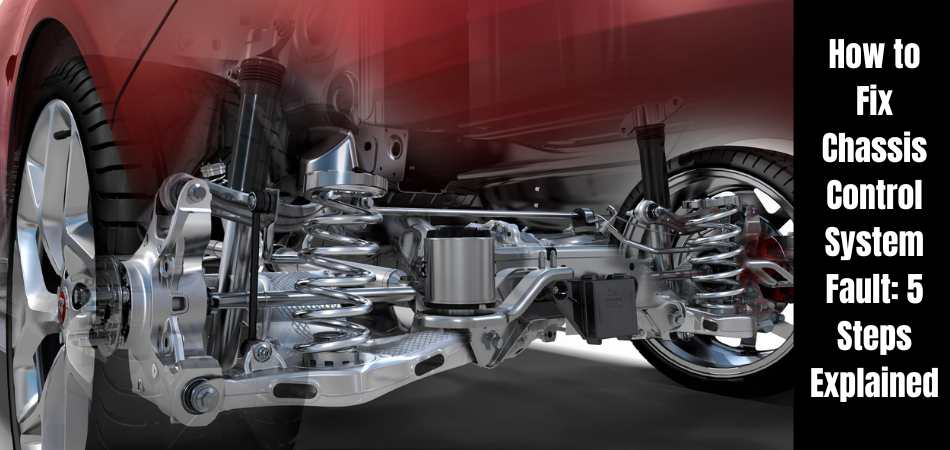
If you are late for work, receiving an error message from your chassis control system can be frustrating. Pressing the Start Engine button usually causes it to appear. If your car is acting up, you might wonder what’s wrong with it. So, How to fix Chassis Control System fault?
Nevertheless, it isn’t immune to problems like any other part of your vehicle. You can avoid unexpected troubles in the future by understanding these issues, their causes, and how to fix them.
Nissan Rogue and other cars with this technology commonly experience chassis control system errors. Any of the three systems can be affected by a fault or problem detected by the chassis control module. These systems include active trace control, active engine brakes, and active ride control.
This guide will give you a better understanding of How to fix Chassis Control System fault; the common problems it encounters, and, most importantly, how to fix them.
What Does Chassis Control Mean?
The chassis control system is one of the features that Nissan Rogue or X-Trail V-Series owners appreciate. As a result of Nissan’s research, the chassis control system is designed to provide a smooth driving experience for the driver while maintaining maximum passenger safety. How does the chassis control system work? In rough terrain, the chassis control is essential to the safety of your vehicle because it collects data about wheel speed, acceleration, G-forces, etc… which prevents too much pressure on the car.
In recent years, chassis control systems have undergone much development thanks to advanced technologies. As the automotive industry advances technologically, chassis control systems are becoming increasingly sophisticated so that driving and turning can be made more smooth. Three leading technologies make up an active chassis control system:
1. Active Ride Control
Depending on the road or terrain conditions, this system will automatically brake and adjust traction to help the car drive smoothly and smoothly on uneven roads. In addition to reducing vibrations on the passengers, the brake system creates a little impact force that does not slow down the vehicle, only allowing the shock absorber to absorb the impact force faster. Additionally, the sensors detect changes in wheel speed to change the engine torque, allowing the vehicle to maintain a steady speed.
2. Active Engine Brake
When cornering or braking, this safety feature assists the driver. As a result of monitoring the vehicle’s speed, steering, and braking systems, the engine braking level will be increased or decreased according to the vehicle’s speed. A driver can reduce the force on the brake pedal with this extra support, which will help smooth driving and make it safer for everyone.
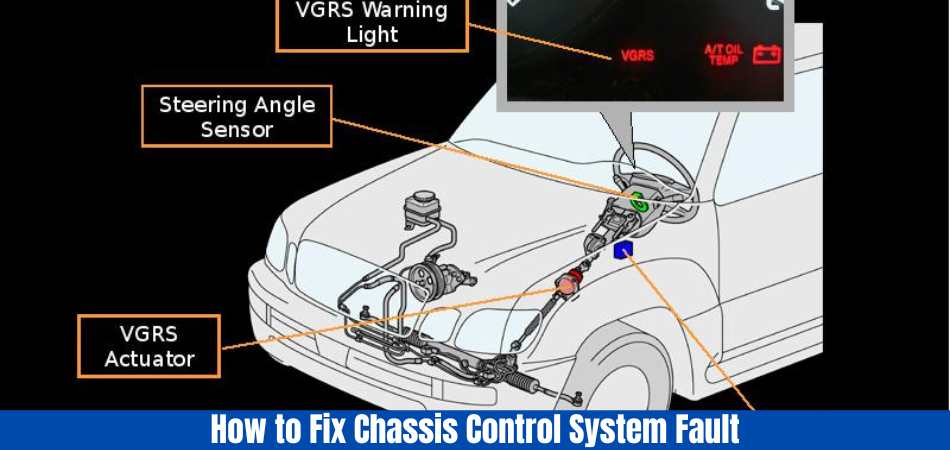
3. Active Trace Control
Using this system, the driver gains more confidence when cornering by adjusting braking force according to steering level, speed, and braking force due to emergency turns or entering or separating highway lanes. When driving the Nissan Rogue at high speeds, over 80 km/h, many Nissan Rogue owners stated that they are very confident; the car turns smoothly at high speeds every time.
The chassis control system combines these three technologies to provide a confident driving experience, as well as a comfortable ride for all passengers. Simply by reading these words, it is difficult to grasp the significance of this system.
What are the Benefits of Chassis Control System?
The chassis control system is a modern technology in Nissan Rogue and select Nissan cars. It has many benefits on all types of roads that improve your driving experience. When the chassis control is activated, a flash will appear on the information display. Here are some of the benefits you enjoy at that time.
1. Improved rider comfort
As a result of the chassis control system in the Nissan Rogue, passengers are able to enjoy better cabin comfort. The system reduces vibrations and up-and-down movements regardless of the road conditions. During cornering and heavy braking, the driver and passengers will not feel thrown out of their seats.
You can control the car with the chassis control system in order to make gentle movements and keep it stable.
2. Confidence among drivers
Driving on uneven country roads can be challenging because stabilizing the car can be difficult. The ability to negotiate sharp bends is also a skill that most drivers lack. You can remain confident knowing you have an assistant behind the scenes when the chassis control system is active.
3. Longer tire life
Controlling the chassis ensures the transaxle’s stability, ensuring even tire tread wear. The tire would only be able to take weight and pressure from one side, especially on rough roads. It is this unbalanced wear that leads to premature tire failure. In general, the chassis control system makes it much easier to get the most out of your tires.
What Is the Chassis Control System Fault?
In order to understand the chassis control error, we need to dig deeper into the role that this system plays in Nissan cars. A new technology specific to Nissan is the chassis control system. The system includes active engine braking, active trace control, and active ride control.
Sensors like wheel speed sensors provide data to the chassis control system. Additionally, it receives information regarding yaw rate, g-forces, and driving forces from steering, acceleration, and braking. This data is then used by the engine control unit (ECU) to control engine braking and transmission systems to improve driving performance. As a result, the technology enhances cornering, braking, and your comfort behind the wheel.
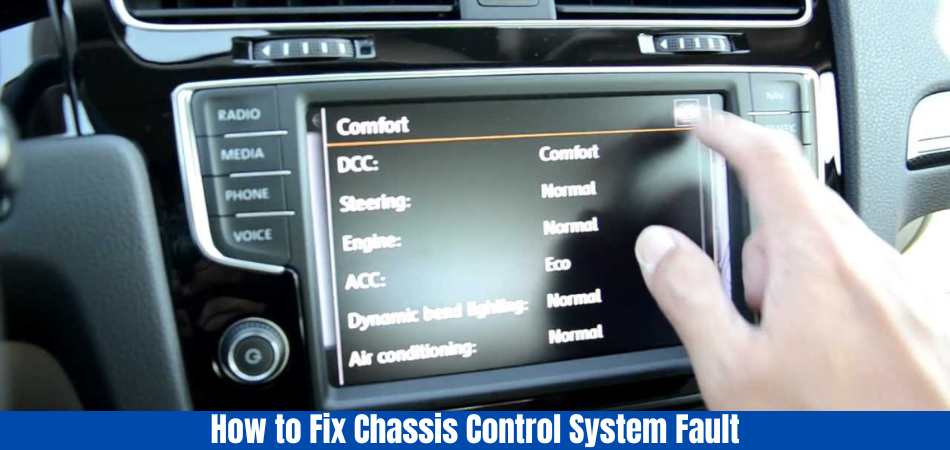
If there is a fault with the chassis control system, an error message appears on the message center. Among these are active ride control systems, active engine braking systems, and active trace control systems. Almost every Nissan Rogue or other model with this technology suffers from this problem.
What are the Common Symptoms of a Chassis Control System Error?
When there is an error with the chassis control system, your car usually won’t remain silent. In order to take early action, you need to be aware of the symptoms that it will use to communicate with you. The following are some common signs that your chassis control system may have a problem:
1. Noisy sounds
A clunking, squeaking, or knocking sound while driving, especially when turning or going over bumps, may indicate something wrong with your chassis.
2. Issues with steering
You may have a problem with your car’s chassis if you have steering problems, such as stiffness in the steering wheel or the vehicle pulling to one side.
3. The uneven wear of tires
A chassis control system ensures an even distribution of weight throughout your vehicle. You may notice uneven or rapid tire wear if there is a problem.
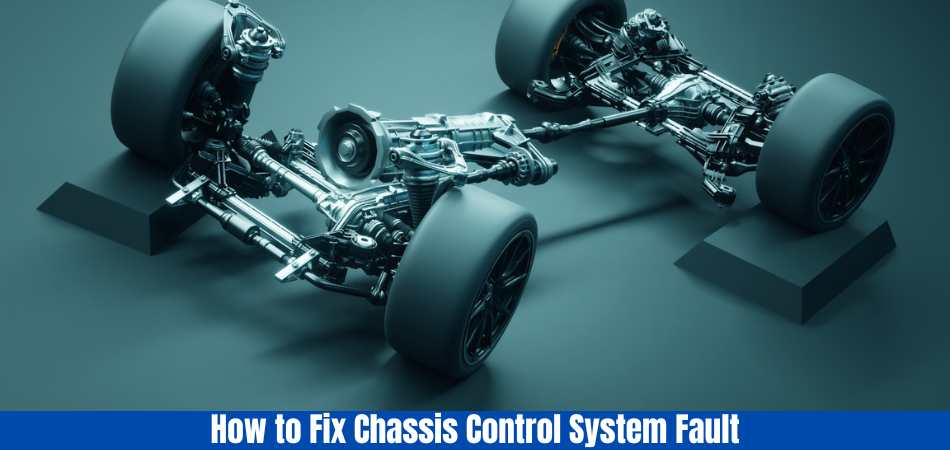
4. The ride quality is poor.
An issue with the suspension, which is part of the chassis system, could be causing your car ride to feel bumpier or less comfortable than usual.
5. Indications of damage
It is possible for the problem to be visually apparent at times. In some cases, the frame or suspension components of your vehicle may appear sagging or damaged.
What Are The Reasons For A Chassis Control System Error?
A chassis control system can sometimes malfunction, just like any electronic system or vehicle component. What are the reasons for this? Here are some possible solutions for how to fix the chassis control system error caused by a faulty chassis control system:
1. A loose connection between the battery and the device
There will be an effect on the current if the car terminal is loose. Having less power going to the electrical systems will lead to faulty electrical parts and sensors in the car, including the chassis control system. Your dashboard will display a warning light at that point.
This error can be resolved by tightening the battery cable if a loose battery connection is responsible. A driver who knows how to switch a wrench or screwdriver can easily tighten the positive or negative cable of their battery connection. To tighten the connection, there will usually be a nut attached to the battery terminal. You can turn this nut as needed.
2. Dead and dirty battery
Battery corrosion or dirt can build up over time, or your battery may be dying. You may also notice that your vehicle has problems starting or with electrical components, especially your chassis control system.
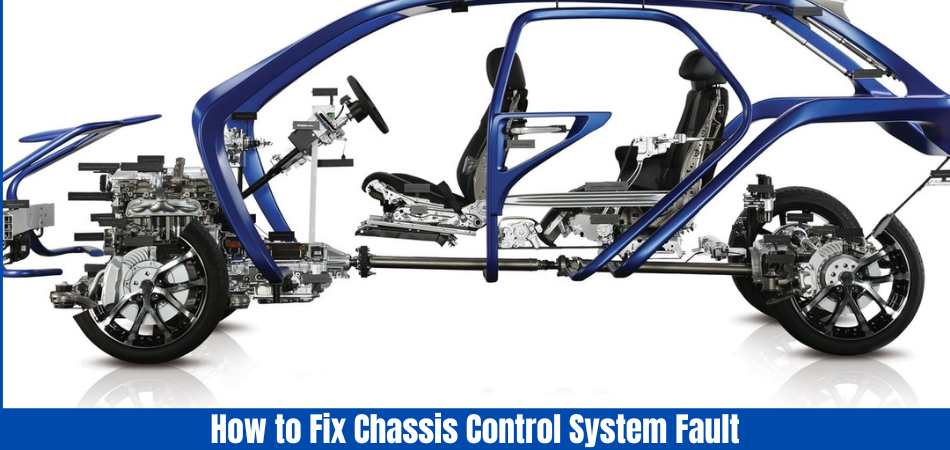
As a result, this system will no longer function and display a warning notification on the dashboard. Cleaning solutions (baking soda) can be applied to the car battery to remove corrosion after rinsing.
Be sure to reconnect the cables after you have cleaned your car battery after disconnecting them.
You can revive a dead battery by following these steps:
- You may be able to jumpstart your vehicle with the help of a second battery, a battery booster, or a jumper cable. Don’t shut off your car engine because the battery won’t accept a charge at that point.
- Distilled water may flood the plates completely when the electrolyte level is low and allow a slightly wider reaction area when the electrolyte level is low. The motor may be able to rev a few more times with this change. Aspirin or Epsom salt can also be used to revive a battery, in addition to distilled water.
- Having a dead car battery prevents the engine from starting, let alone the chassis control system from functioning.
There is usually a way to revive a dead car battery – at least temporarily – so that you can keep driving. Nevertheless, it is inevitable to replace your battery sometimes, even if it can be revived.
3. Failure of the ABS sensor
When you brake, your car’s ABS sensors and module work together to keep it stable. Because they measure the wheel speed, ABS sensors are also known as wheel speed sensors.
A wheel rotation and speed sensor monitors the wheels’ rotation and speed. The ABS sensor cannot provide data to your chassis if it is not functioning, so an error can occur in your chassis control system. The ABS sensor may need to be repaired or replaced to fix this problem.
4. Issues with ground lead
When the ground lead has some faults or shows an error sign, the chassis control cannot operate. Your car’s ground lead is the connection between the minus battery terminal and the chassis.
A wire like this can be easy to overlook, but it plays a crucial role in the entire electrical system of your car. The ground cable of this battery conducts all the current flowing in your vehicle.
Your car will have electrical problems if you don’t have a good ground lead, and the chassis control will malfunction. Having these issues won’t be just a minor inconvenience since they will affect the operation of your vehicle. Finding and replacing the defective ground lead with a fresh one is the best solution in this situation.
5. Wiring harness with a defect
In a wiring harness, power and information are transmitted through wires. Besides being an insulating tube, it contains cables and wires that connect various electrical and electronic components of your car.
In an organized manner, wires can pass through it. Your car will not start if the chassis fails to send commands to other components due to defective wires. The defective wires need to be found and fixed.
How to Fix Chassis Control System Fault?
As soon as you’ve diagnosed the problem, you can begin addressing it. But How to fix Chassis Control System fault? The following are some common issues you might encounter and how to fix them:
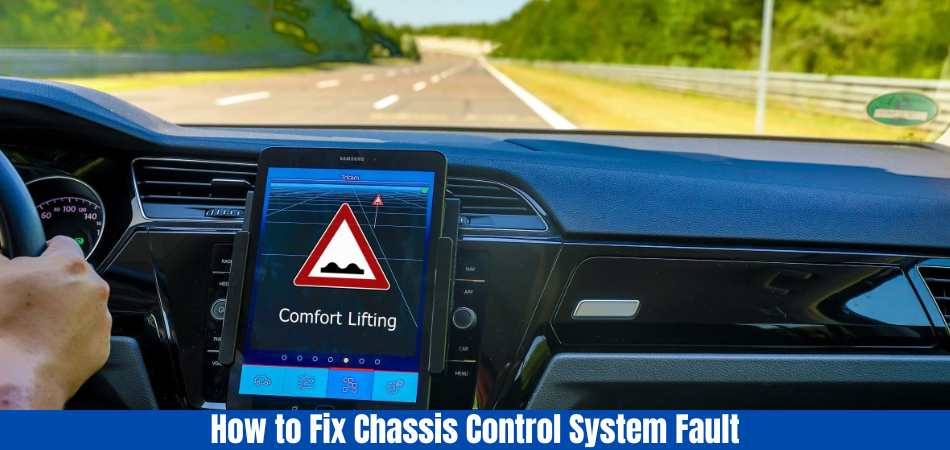
1. Fixing Suspension Issues
Problems with the suspension are some of the most common chassis control system issues. The reason for this could be worn shock absorbers, struts, or springs. These parts need to be replaced in order to fix this problem.
It is essential to replace suspension components in pairs (both front and rear) in order to maintain a balanced handling system.
2. Fixing Steering Problems
Wearing tie rods, a damaged power steering pump, or a leaking steering rack may cause the steering system to malfunction. It may be necessary to replace the faulty parts depending on the issue. It might be possible to fix the problem by topping up the power steering fluid.
3. Frame Damage
If An accident or other cause of damage to the vehicle frame requires a professional to inspect and repair it. In order to ensure the vehicle is safe to drive, specialized equipment and skills must be used to fix the frame.
4. Brake System Issues
Chassis control systems can also be affected by brake system problems. Brake pads that are worn, brake fluid that is leaking, or brake rotors that are faulty may cause this to happen. The brake pads may need to be replaced, the leak may have to be sealed, or even the entire brake assembly may need to be replaced.
5. Wheel Alignment
Uneven tire wear and poor handling can result from incorrect wheel alignment. If this is the case, you should take your car to a professional to have the wheels realigned.
It’s important to remember that every vehicle is different, even though these are general guidelines. The specific issues that your car might have will depend on its make, model, and year.
Get professional assistance if the problem is severe or complex, or refer to your vehicle’s manual for specific repair instructions.
It is always essential to put safety first. Consult a professional mechanic if you are unsure or uncomfortable performing repairs.
How to Prevent Chassis Control System Errors?
It is better to prevent than to cure, as the saying goes. Several steps can be taken to prevent issues from arising with your car’s chassis control system.
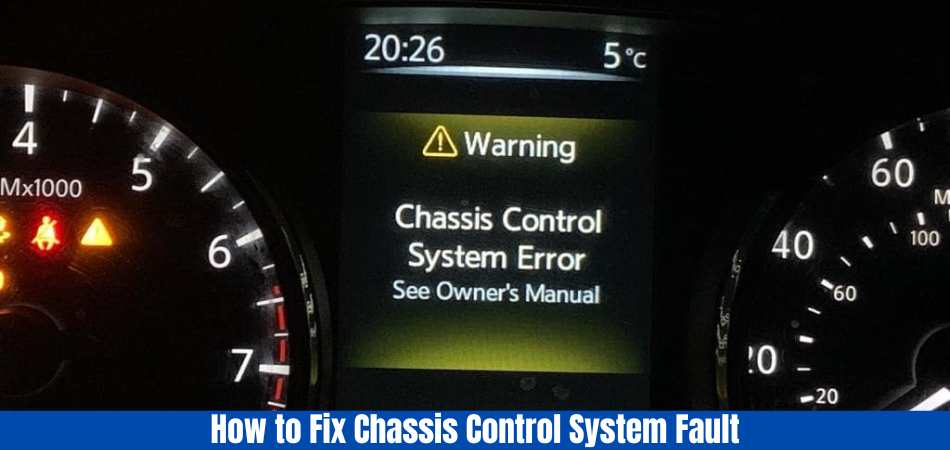
1. Maintaining regularity
Preventing issues with your car is as simple as maintaining it properly. Maintaining your vehicle means changing the oil regularly, checking the fluid levels, inspecting the brakes, and aligning the wheels regularly.
2. Tire inspection
In addition to being the only part of your vehicle that makes direct contact with the road, tires play a crucial role in chassis control. Keep an eye out for uneven tire wear, which may indicate an alignment or suspension problem.
3. Beware of overloading
The maximum weight of each vehicle is determined by its design. It is possible for the chassis to be damaged if the vehicle is consistently overloaded. Make sure your vehicle’s weight limit is within the manufacturer’s recommendations.
4. Drive carefully
The way you drive can have a significant impact on the health of your car. Be careful not to drive aggressively since this will stress the chassis and its components extra. Avoid damaging your undercarriage by being cautious when driving over speed bumps or potholes.
5. Inspecting regularly
Keep an eye out for signs of wear or damage to your vehicle on a regular basis. Among the things to check are the frame and suspension for rust or dent damage, as well as the steering for any problems.
By following these steps, you can significantly reduce your chances of running into issues with your chassis control system. Taking good care of your car is not just about saving money on repairs, and it’s about ensuring your safety and comfort.
Conclusion: How to Fix Chassis Control System Fault
Now you have some idea of, How to fix Chassis Control System fault? Knowing how your car’s chassis control system works, you can spot potential problems before they become serious.
This guide covers everything from knowing the common symptoms of chassis control system errors to understanding their causes and fixing them.
Your best bet for preventing issues and ensuring your vehicle’s long and healthy life is routine maintenance and inspections. Do not hesitate to consult a professional mechanic if you encounter a problem you are unsure of.
Read more of our articles here.
Read Also: What Is Chassis Control System?
FAQs
What is a chassis control system fault?
An electronic chassis control system fault refers to a malfunction or error in the systems that manage and control the vehicle’s chassis, such as stability control, traction control, and antilock braking.
What are the common signs of a chassis control system fault?
When a chassis control system is malfunctioning, what are the common signs ABS or traction control lights), unusual handling or braking behavior, and strange noises during driving? An investigation should be conducted if there is a sudden change in the vehicle’s stability.
How do I diagnose a chassis control system fault?
An error code can be retrieved from a vehicle’s computer using a diagnostic scanner to diagnose a chassis control system problem. These codes provide information about specific chassis control system issues.
Can I fix a chassis control system fault myself?
In some cases, DIY enthusiasts can fix some chassis control system issues, but as these systems are complex, a professional mechanic should diagnose and fix the problem. Incorrect repairs can compromise vehicle safety.
How much does it cost to repair a chassis control system fault?
In addition to the fault type, the make and model of the vehicle, as well as local labor rates, the cost varies. Sensor replacement, for instance, may be less expensive, whereas more complex problems may cost more.







Leave a Reply